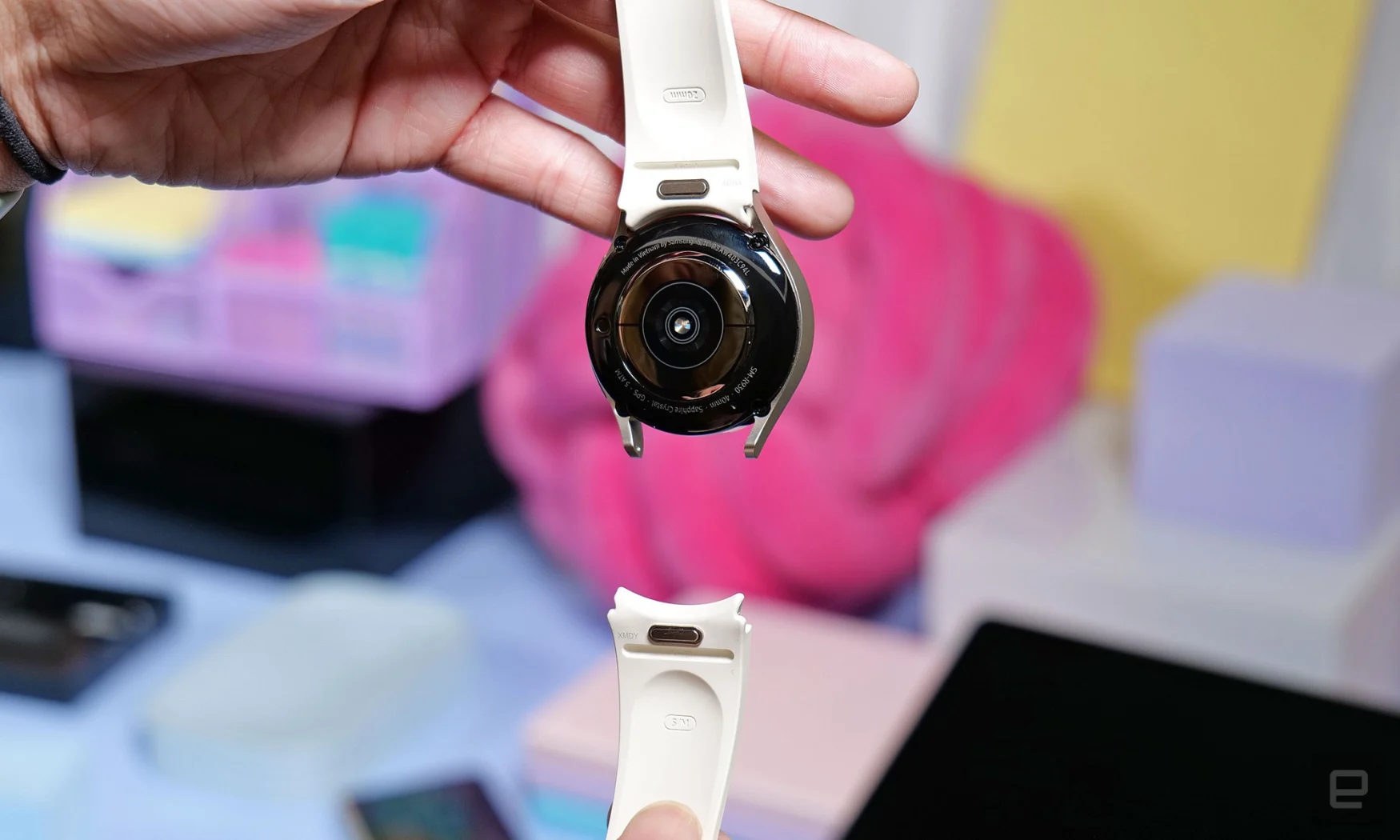Samsung Galaxy Watch 6 hands-on: The spinning bezel’s triumphant return
While Samsung’s latest Galaxy Watches might not be the highlight of its second Unpacked event this year, they’re arguably the most anticipated Android smartwatch launch every year. One of the most conspicuous absences from the last model was the fan-favorite spinning bezel that’s long been a hallmark of Samsung’s wearable. With the announcement of the Galaxy Watch 6 series today though, the bezel is back. Specifically, Samsung has unveiled two new models — the Galaxy Watch 6 and the Galaxy Watch 6 Classic, and the latter sports a smaller rotating bezel than the last generation that did. That, along with some physical refinements, are the most obvious changes on the hardware front, while health-tracking continues to be a focal point for the Galaxy Watch series.
Physical and hardware changes
Samsung reps had a Galaxy Watch 5 at the event and when I held it next to a Watch 6, I could see how much cleaner the design was. While the company did shave some fractions of an inch off the case, that’s not as noticeable as the fact that the screen now lies flush with the lugs.
Adding to the sleeker appearance is the Watch 6’s display, which is now 20 percent larger than the previous model, thanks to a bezel that’s 30 percent slimmer. On the Classic, Samsung managed to make the physical spinner 15 percent smaller, too, so it also has a 20 percent bigger display.
Despite its smaller size, the mechanical bezel on the Watch 6 Classic seems just as easy to use as before. I could still feel individual grooves under the frame as I jumped through apps and widgets by rotating the wheel, using each notch as a tactile cue to figure out what page I was on. And credit to Samsung for bringing back this glorified fidget spinner without making the Classic too bulky, although it comes in larger sizes (43 and 47mm) than the standard model (40 and 44mm).

Subscribe to the Engadget Deals Newsletter
Great deals on consumer electronics delivered straight to your inbox, curated by Engadget’s editorial team. See latest

Please enter a valid email address
Please select a newsletter
By subscribing, you are agreeing to Engadget’s Terms and Privacy Policy.
In addition to getting bigger, the Watch 6s’ panels are sharper and brighter than before too, going up 2,000 nits this year. You can also adjust the brightness of the Always On Display, which is nice on a sunny day or when you’re running low on juice.
As with each smartwatch launch, the company has also added faces and straps for the Watch 6 series that older generations can use too. But what’s intriguing this year is a new “one-click” mechanism for some bands that should make swapping them easier. It took a few tries to figure out, but once I did I found it simpler than the Pixel Watch’s version. All you need to do is push down on a button then lift the strap up out of the lug. Putting it back in is a matter of holding down the button and aligning the screws to the lug, then letting go.
Other physical changes to the Watch include an updated processor and larger battery. Samsung says you can get eight hours of juice on eight minutes of “fast charge,” so if you’re running low and still want to track your sleep, you should be able to plug in and quickly get enough power to last all night.
Sleep tracking and insights
Speaking of, some of the biggest updates to the Galaxy Watch series are coming to its sleep-tracking and coaching features. For those who wear the watch to bed, more insights are coming. Samsung says the Watch 6 will give users “in-depth analysis of Sleep Score Factors” like total sleep time, cycles, awake time and new parameters the company is calling “physical and mental recovery.”
Samsung also worked with the National Sleep Foundation to co-develop “more individualized Sleep Messages” that give users feedback each morning about their night. The Watch 6 can also recognize patterns around your sleep and wake times to see how consistent you are, and assign a “Sleep Animal Symbol” to represent your style. This is very similar to what Fitbit and Google offer with the Pixel Watch, but Samsung is not locking this behind a paywall.
Sadly, I wasn’t able to test any of these new sleep-related features (I’ve been asked to stop napping on the job), and some of them take at least seven days of wear to kick in, so we’ll have to wait till we get in a sample for testing before I can evaluate these.
Fitness, heart rate and other updates
Other updates I wasn’t able to truly gauge include the new Samsung Wallet app (instead of just the Pay widget), personalized Heart Rate Zone calibration for running workouts and irregular heart rhythm notifications. But I can tell you what they’re supposed to do.
The Samsung Pay feature on the watch has been replaced by the Wallet, which means you can use digital IDs (where compatible), boarding passes, event tickets and loyalty cards on the watch. There’s also a new Track Run workout type that logs the number of laps you complete, while the personalized Heart Rate Zone tool requires you to go through a ten-minute calibration session before it gives you five “optimal running intensity levels” so you can exercise to activate processes like fat-burning.
When the Galaxy Watch 6 detects heart rhythms that might suggest atrial fibrillation, it will prompt you to run an electrocardiogram test. It’ll monitor your pulse in the background for such patterns, including when you’re asleep. Overnight, the Watch 6 series’ onboard skin temperature sensor will also kick in to gather data that can help determine what stage of your menstrual or ovulation cycle you might be entering.

Samsung also introduced a Skin Temperature API under its “Privileged Health” software development kit (SDK) that will allow third parties to create different applications for the Watch’s LED infrared sensor or the temperature data that it gathers. One example is a new Thermo Check app that lets you measure water temperature before you have to dip into a pool. (Of course, if you’ve stuck your whole hand in the water, you probably already know if it’s too cold.)
A number of third-party apps have also been brought over to or optimized for the Watch 6, as well as other watches running Wear OS 4. These include WhatsApp, Google Calendar, Gmail, Audible, along with updated versions of Peloton and MyFitnessPal. Samsung also tweaked its Camera Controller app to let you remotely snap pictures, switch modes and zoom from the latest foldable phones (in addition to boring ol’ regular handsets). Find My Phone on the Galaxy Watch will now show where your misplaced device is on a map, as well.
For obvious reasons, I wasn’t able to test most of these updates — given I couldn’t simply go running for ten minutes at a hands-on, and it probably would have been a bad idea to load my credit card on the demo units. But I don’t feel as if I missed out on much. The most significant changes appear to be cosmetic and many of the software updates might eventually trickle down to older models. I’m intrigued by the sleep insights Samsung looks set to deliver, but that will take at least seven days for me to start seeing results. Stay tuned for our full review to see how the Galaxy Watch 6 performed on that front, but also for the details on battery life and real-world experience. Until then, if you’re ready to get a new Android smartwatch, you can already pre-order the Galaxy Watch 6 and Watch 6 Classic now starting at $300 and $400, respectively, from Samsung and Amazon. They’ll be available starting August 11th.
Samsung is also making some tweaks to last year’s Galaxy Watch 5 Pro, adding access to hiking routes via the GPX (GPS Exchange Format) File Database as well as more options for Route Workout types. You can still buy that device for $450.
